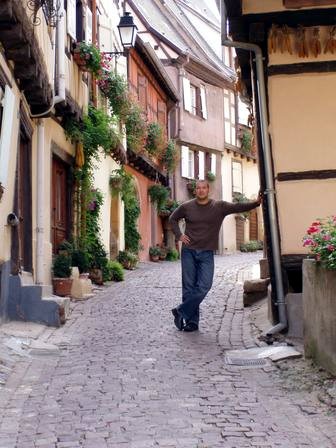I have not posted for far too long. In the interim, I have taken a new job, as Director of Winemaking for the company which purchased EOS winery last year. It has been a challenging and exciting few weeks; I really like all the people whom I work with, and I can see that we all want to make a success of the project. And some other things have gone down, which I won't go into at this point, but which are equally complex...
Currently, I am writing from Barcelona. I know, I know, I should be out enjoying the amazing ambiance, food, music, nightlife, etc... instead of writing blog posts. Don't you worry - it is still early! And I already put in a full night last night, and a full day today.
I picked up some things for a snack at the market, so I am nibbling on fresh cherries and Jamon Serrano, the incredible Spanish delicacy. It is no secret that I adore the pig. And perhaps nowhere in the world does the pig achieve the gustatory heights that it does in Spain's Jamon Serrano and Jamon Iberico.
Jamon Serrano is a dry-aged ham from a specific breed (the Landrace, which has been regarded as the tastiest even back to the time of the Romans,) of pig. It is trimmed and then packed in salt for about 2 weeks to draw out moisture and preserve the flesh, then hung to dry age at altitude for 14-20 months to cure. At any Jamon stall in the market, there are 10-15 different Jamons on offer, all hanging from the hoof on display. Upon ordering, the butcher slices tiny, paper-thin bits which almost melt in your mouth. Amazing. I have had Jamon Serrano served sliced thinly over the Pan con Tomato that is a common tapas offering here, a salty, fruity compliment to the bread. Jamon Serrano has an almost dried-fruit sweetness, and the texture is ever so slightly stringy. When layered on a plate, it has an almost jewel-like sheen.
Jamon Iberico is something completely different. It is only made from the Black Iberian Pig, which lives on the border of Spain and Portugal. These pigs are taken immediately after weaning and fattened on grains before being turned out to forage naturally on pasture under the cork-oak forests, eating herbs, grasses, wildflowers, nuts, and tubers. Prior to slaughter, their diet is restricted according to the level of Iberico - for the very best, the Iberico de Bellota, they must eat a diet entirely of acorns. These hams sell for upwards of 125 euro per kilogram!! I purchased some of each today - a packet of 100g or so - the Serrano was 4.95 euro, the Iberico was 21.45!!!!
Anyway, the market is incredible. It is my favorite thing here, and Sagrada Familia does not make that an easy race to win! Walking around, watching tourists snapping photos of the bizzare fish, flesh, fruit, and fromage on display, it just is so clear how differently we have our food presented to us in the US. There was an entire stall with a butcher devoted to selling offal - livers, tripe, intestines to use as sausage casings, even whole, skinned lamb's heads, with the eyes intact and vibrant staring back at everyone... The level of display is amazing - the fruit drinks that are on offer are brilliant, delicious, and refreshing (I had a Cheromoya drink, and a cactus-flower one, both delicious - who needs Coca-Cola!) Fish that are still flopping on the table, flowers, wine, gorgeous vegetables, dried fruits, preserved fruits, chocolates - almost every food imaginable with the curious exception of bread - I did not see any bakeries there.
We Americans have become so sadly separated from the glorious, noble, often violent, but always genuine origins of our food....
Alright, now it is time to get out and enjoy the evening!
Saturday, May 31, 2008
Subscribe to:
Posts (Atom)






